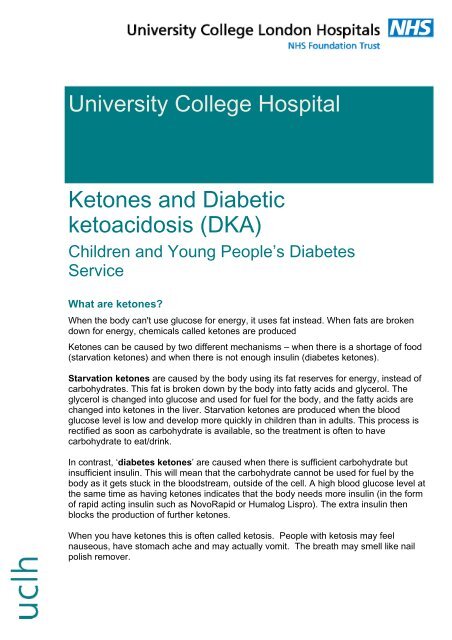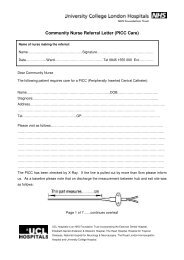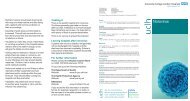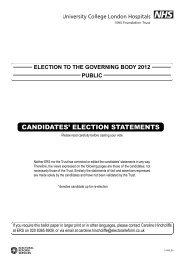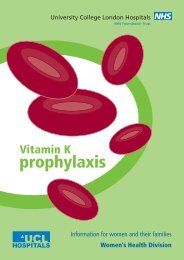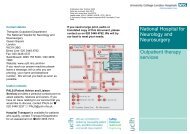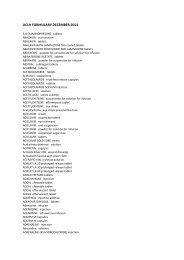Ketones and Diabetic ketoacidosis (DKA) University College Hospital
Ketones and Diabetic ketoacidosis (DKA) University College Hospital
Ketones and Diabetic ketoacidosis (DKA) University College Hospital
Create successful ePaper yourself
Turn your PDF publications into a flip-book with our unique Google optimized e-Paper software.
<strong>University</strong> <strong>College</strong> <strong>Hospital</strong><br />
<strong>Ketones</strong> <strong>and</strong> <strong>Diabetic</strong><br />
<strong>ketoacidosis</strong> (<strong>DKA</strong>)<br />
Children <strong>and</strong> Young People’s Diabetes<br />
Service<br />
What are ketones?<br />
When the body can't use glucose for energy, it uses fat instead. When fats are broken<br />
down for energy, chemicals called ketones are produced<br />
<strong>Ketones</strong> can be caused by two different mechanisms – when there is a shortage of food<br />
(starvation ketones) <strong>and</strong> when there is not enough insulin (diabetes ketones).<br />
Starvation ketones are caused by the body using its fat reserves for energy, instead of<br />
carbohydrates. This fat is broken down by the body into fatty acids <strong>and</strong> glycerol. The<br />
glycerol is changed into glucose <strong>and</strong> used for fuel for the body, <strong>and</strong> the fatty acids are<br />
changed into ketones in the liver. Starvation ketones are produced when the blood<br />
glucose level is low <strong>and</strong> develop more quickly in children than in adults. This process is<br />
rectified as soon as carbohydrate is available, so the treatment is often to have<br />
carbohydrate to eat/drink.<br />
In contrast, ‘diabetes ketones’ are caused when there is sufficient carbohydrate but<br />
insufficient insulin. This will mean that the carbohydrate cannot be used for fuel by the<br />
body as it gets stuck in the bloodstream, outside of the cell. A high blood glucose level at<br />
the same time as having ketones indicates that the body needs more insulin (in the form<br />
of rapid acting insulin such as NovoRapid or Humalog Lispro). The extra insulin then<br />
blocks the production of further ketones.<br />
When you have ketones this is often called ketosis. People with ketosis may feel<br />
nauseous, have stomach ache <strong>and</strong> may actually vomit. The breath may smell like nail<br />
polish remover.
When are ketones dangerous?<br />
Sometimes in people with diabetes ketones can build up to a dangerous level <strong>and</strong> this is<br />
called diabetic <strong>ketoacidosis</strong> or <strong>DKA</strong>.<br />
Several things have to go wrong to get to this state:<br />
Blood glucose must be high<br />
Insulin levels must be low<br />
The body must be breaking down fat stores<br />
High levels of glucose <strong>and</strong> ketones make the blood acid <strong>and</strong> make you urinate more often<br />
leading to increased thirst.<br />
Symptoms of <strong>DKA</strong> are:<br />
Loss of appetite<br />
Stomach ache<br />
Blurred vision<br />
Fever, flushed or warm<br />
Difficulty breathing<br />
Weakness <strong>and</strong> sleepiness<br />
Smell of ketones on breath<br />
Treatment for <strong>DKA</strong> needs:<br />
Treatment in hospital<br />
Fluids to reverse the dehydration<br />
Insulin (via a drip) to force glucose into cells<br />
Electrolytes such as sodium <strong>and</strong> potassium to replace those lost in the urine<br />
See our ‘Sick day rules’ for advice on what action to take if you find your child has<br />
ketones.<br />
How to prevent <strong>DKA</strong>?<br />
Take insulin regularly <strong>and</strong> adjust amount depending on your blood glucose <strong>and</strong><br />
ketone levels. Follow your sick-day rules.<br />
Don’t stop taking insulin if you are unwell<br />
Drink enough water to prevent dehydration<br />
Don’t exercise if you have ketones<br />
Call the Diabetes team for advice if you are concerned or unsure of what to do<br />
2
When to test for ketones?<br />
Ketone testing lets you know what is happening <strong>and</strong> means you can get on top of the<br />
problem quickly. Test for ketones when:<br />
<br />
<br />
<br />
You are ill. Check blood glucose <strong>and</strong> ketones at least every 2-4 hours<br />
You feel nauseated or actually vomit<br />
You have 2 consecutive blood glucose levels >14 mmol/l<br />
How to test?<br />
There are two ways of detecting rising ketones. You can test your urine (measuring<br />
acetoacetate) or your blood (measuring beta-hydroxybutyrate).<br />
<strong>Ketones</strong> accumulate in your urine over several hours, so measuring them in urine cannot<br />
tell you what your levels are right now. Testing your blood for ketones will allow you to<br />
identify ketones earlier <strong>and</strong> will normalise sooner, following treatment. This helps prevent<br />
later hypoglycaemia from over insulin treatment.<br />
Contact Numbers:<br />
Office Hours (8am – 6pm): 020 3447 9364 (Children’s Diabetes Nurses)<br />
Out of Hours:<br />
020 3456 7890 <strong>and</strong> page Paediatric On-call Registrar<br />
Further information <strong>and</strong> fact sheets can be found on our Children <strong>and</strong> Young People’s<br />
Diabetes web page at http://www.uclh.nhs.uk/<br />
or by emailing us at childrensdiabetesnurses@uclh.nhs.uk<br />
Expert advice <strong>and</strong> information about children <strong>and</strong> young people's type 1 diabetes at<br />
www.uclh.nhs.uk/T1<br />
If you need a large print, audio or translated copy of this document, please<br />
contact us on 020 3447 9364. We will try our best to meet your needs.<br />
First published: 19/07/13<br />
Date last reviewed: 19/07/13<br />
Date next review due: 19/07/15<br />
Leaflet code: UCLH/SH/PAED/CYPDS/KETONES/1<br />
© <strong>University</strong> <strong>College</strong> London <strong>Hospital</strong>s NHS Foundation Trust<br />
3


